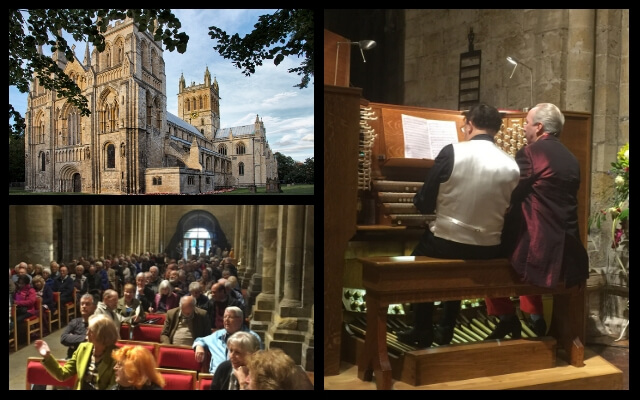So called ‘organ battles’ have been around for years but I suppose did not feature much in musical life until it was possible to move an electronic instrument into a venue to ‘compete’ with the pipe organ. There are some well known venues with more than one pipe organ but the second instrument is often much smaller than the main instrument so battles in these locations are perhaps a bit of an euphemistic description.
In any event these encounters should always be musically driven and not overly resort to a slogging out of competing force and volume.
A battle or a dialogue?
In my opinion much of the fun of these encounters is use of the instruments in dialogue with the audience being further enthralled as sound moves around the building from 2 instruments in a way that it does not from a single instrument.
Our last organ battle concert was in the Caird Hall Dundee when Carol Williams and Kevin Bowyer put on the show and entertained us with their banter as well as they playing. These events should add ‘entertainment’ into the mix and pull in a wider audience who will experience a very different take on an instrument they will most often have heard in a religious context.
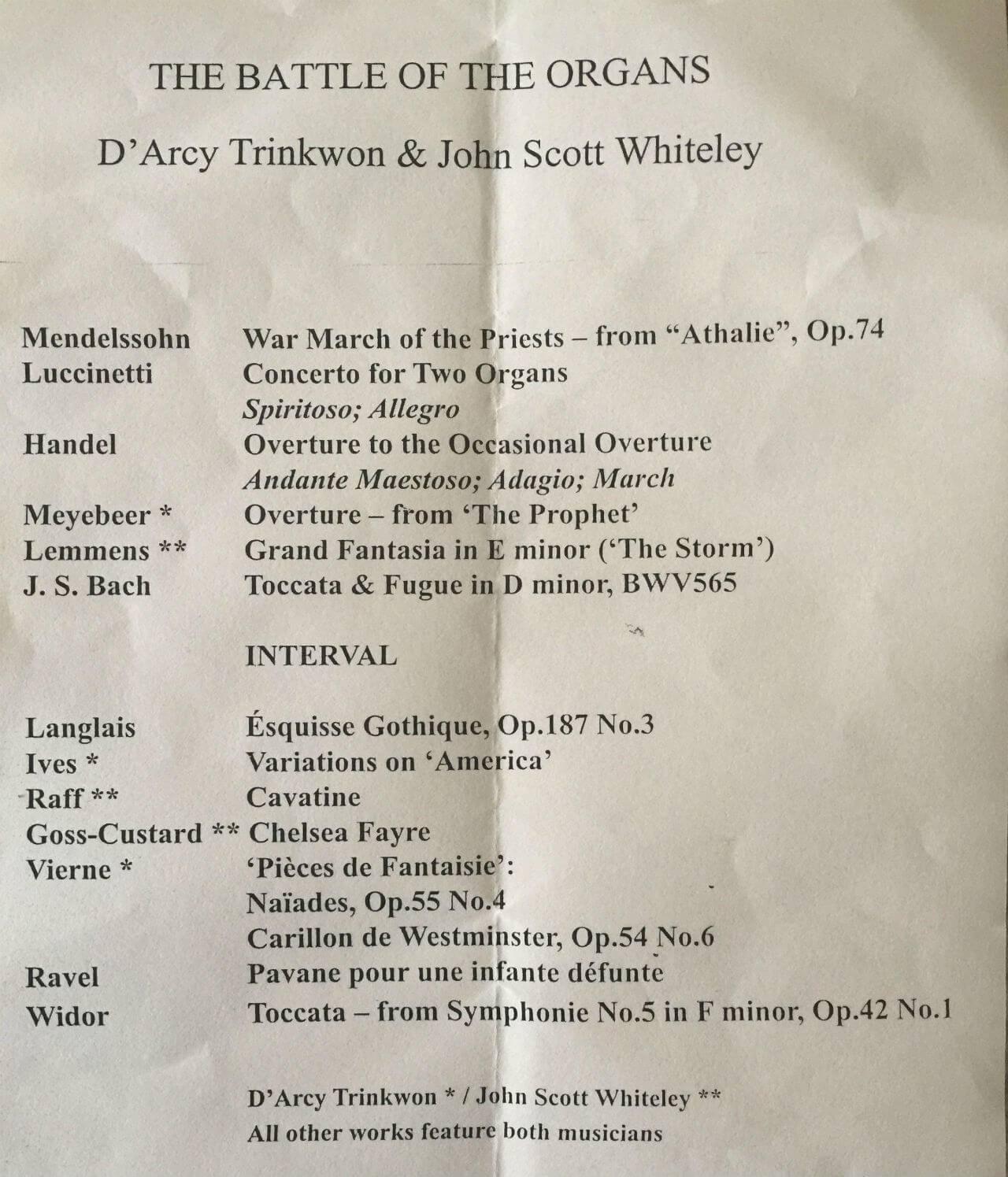
Two great organists performing and entertaining
The stars of stage (and screen) in Selby were John Scott Whiteley and D’Arcy Trinkwon, both very accomplished musicians. Its probably fair to say they have quite different styles but they combined well to entertain in both playing and presentation. Alternately explaining in some detail the background to the programme.
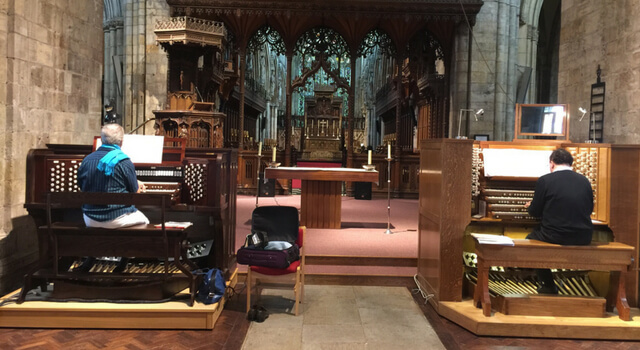
We were also joined by another very accomplished organist Keith Hearnshaw in his role as cameraman and projectionist. All too often the extraordinary work that an organist has to do is unseen, hidden away as they often are in a loft. The Selby facility of a nave console and our instrument set by its side did allow a lot of people to get a direct view of the organs.
For those further back an additional large screen set between the 2 instruments gave a better view. Although I had a front row seat I found myself often looking at the screen as it allowed a far better view of the keyboard work, the camera being set high and to the side and so players backs were not obscuring its view of hands.
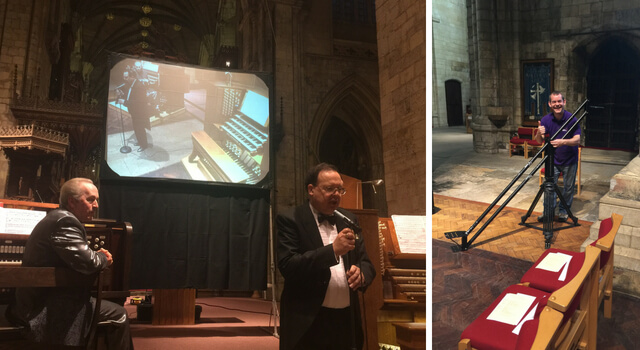
First half kicking off with a “war”
The concert kicked off with War March of the Priests played on both instruments. One was immediately aware of the different sound locations. The pipe organ speaking from the choir behind the players. Our instrument from high up in the triforium with the occasional dose of west end tuba from a pair of speakers we had left there and if I am honest not quite up to the power that was sent their way. There is very little space at that location and we were forced to use speakers smaller than we would otherwise have installed.
Next up was a charming piece written for 2 instruments. Light flute work on both instruments just bounced about as they took it in turn to chatter away to each other in classic renaissance style.
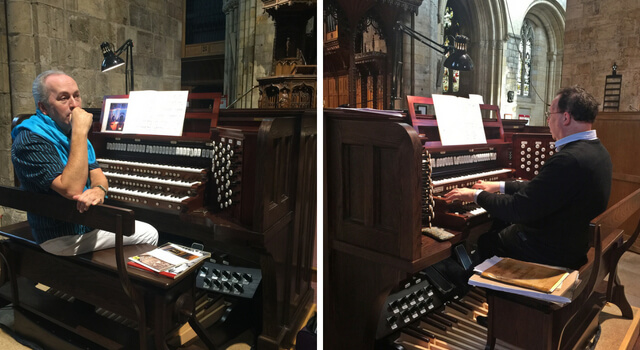
The Handel originally planned for both instruments was eventually split with John playing the first 2 movements on the Hill organ and D’Arcy the last 2 on our Skinner instrument. The task of co-ordination at volume being just too tricky in the opening sections. This worked well with the Hill left to do the powerful beginning while D’Arcy found some wonderful delicate sounds including the lush American strings for the Adagio. The first half concluded with both instruments hitting out at the well known Bach Toccata and Fugue in D minor.
Second half ending in an “alliance”
The second half commenced after a 20 minute refreshment break with the Esquisse Gothique Opus 187 no 3 written for two organs. A monster of a piece that used the full resources of both instruments. D’Arcy then played the Ives variations on America on the Hill which many will know is the same tune as our National Anthem. Jon then gave us an arrangement of the Raff Cavatine and Chelsea Fayre by Goss-Custard on the Skinner instrument. I can not help but smile every time I hear Chelsea Fayre and one day with practice may even pull off an accomplished performance myself.
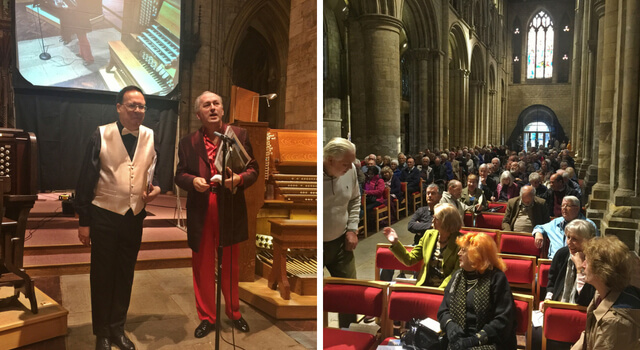
D’Arcy then gave a lovely performance of Vierne’s Naiades on the Hill which just floated about the huge building. This is writing for the organ in a large space of the highest order though I would certainly not like to attempt the piece without a generous acoustic to help hold the structure together. After this came his Carillion de Westminster.

The evening then formally concluded with Ravel’s Pavane pour un infante defunte and the Toccata from Widor’s 5th Symphony played on both instruments.
As a final encore our duo both sat at the Hill organ and sent us home to the sounds of the Sousa March Stars & Stripes, John dealing with the ‘Um-Cha’ in both hand and feet while D’Arcy dropped the melody on top. Great fun, great evening and a great audience. We must do it again.
I have had a passion for church organs since the tender age of 12. I own and run Regent Classic Organs with a close attention to the detail that musicians appreciate; and a clear understanding of the benefits of digital technology and keeping to the traditional and emotional elements of organ playing.
